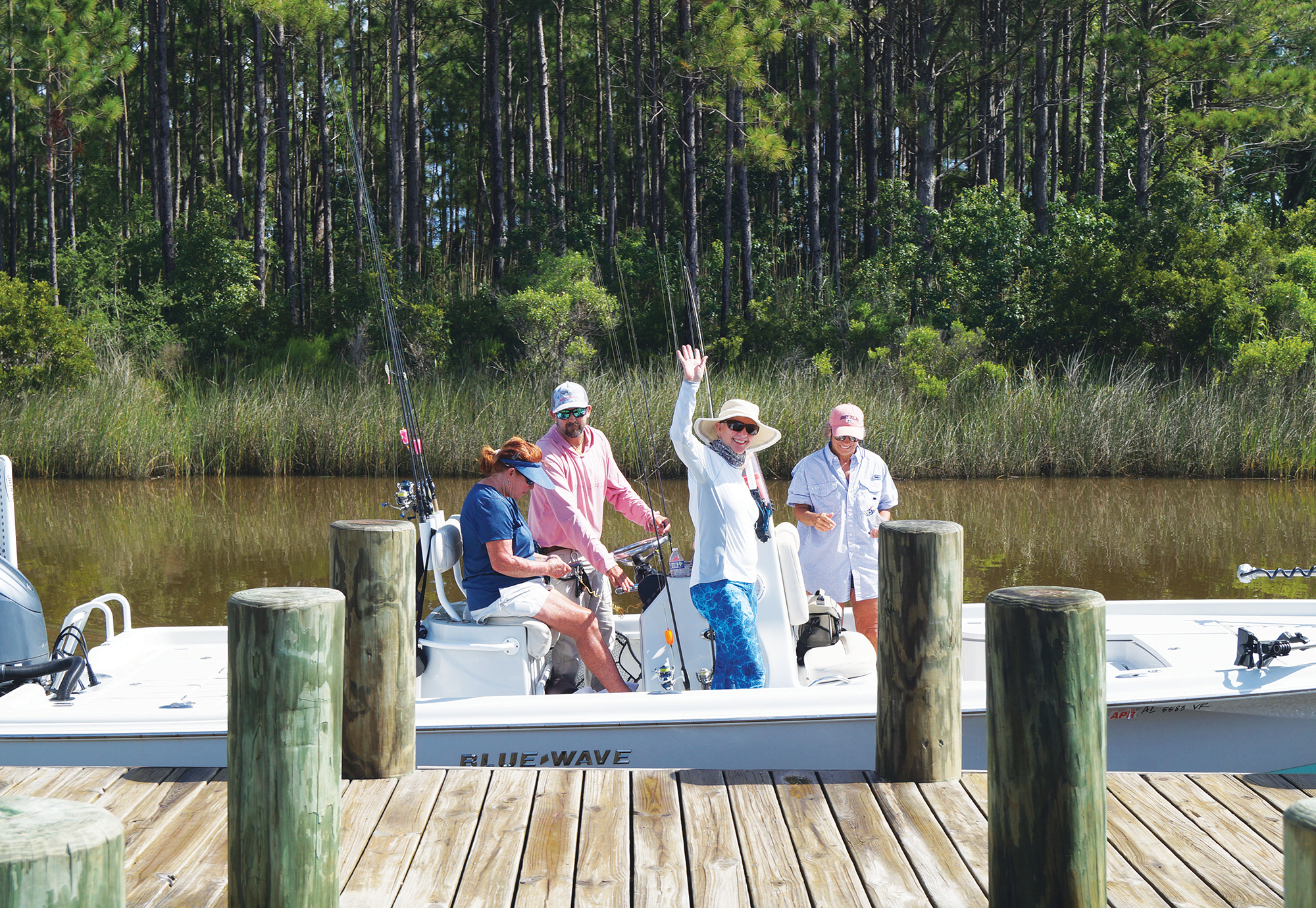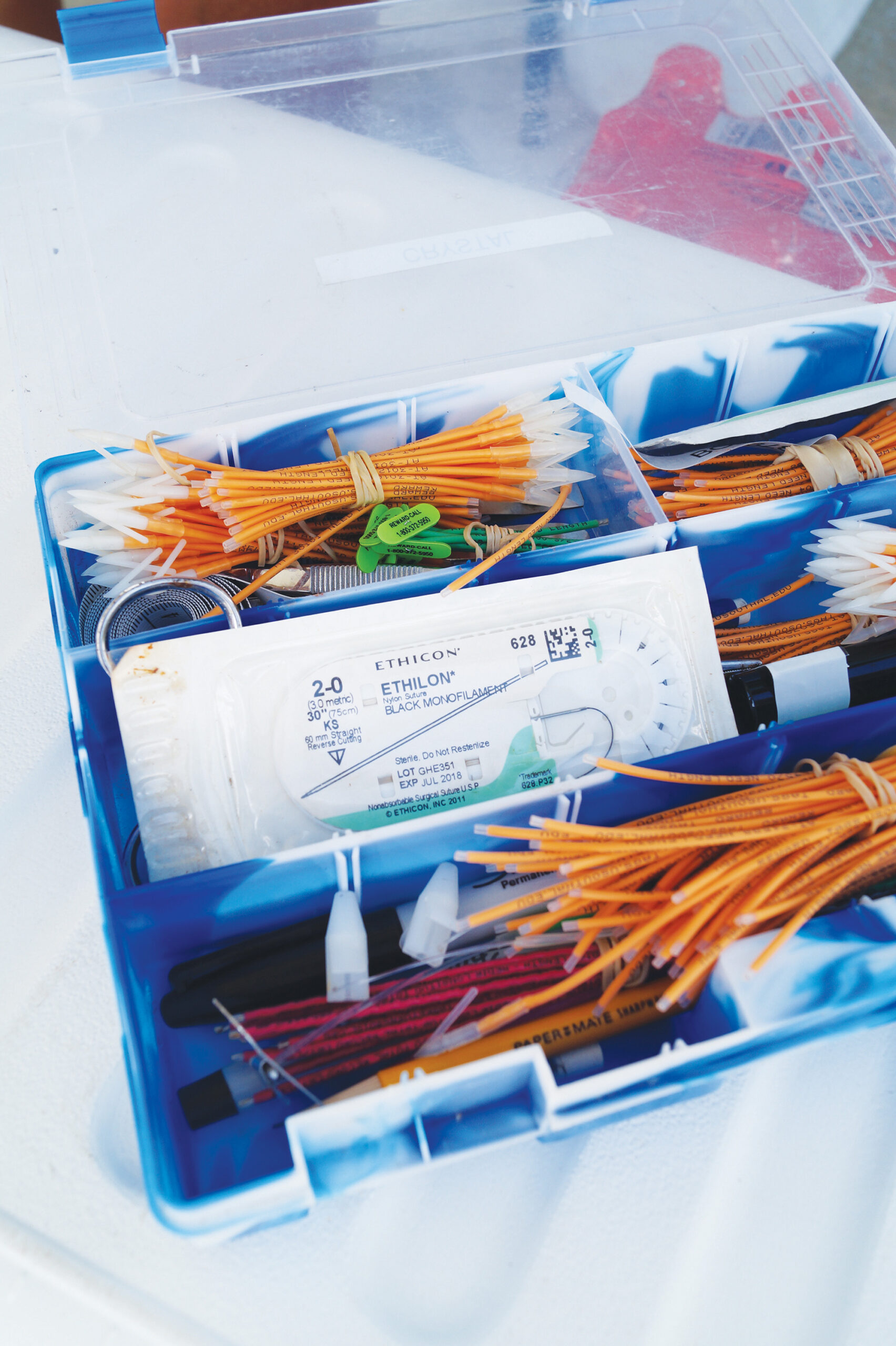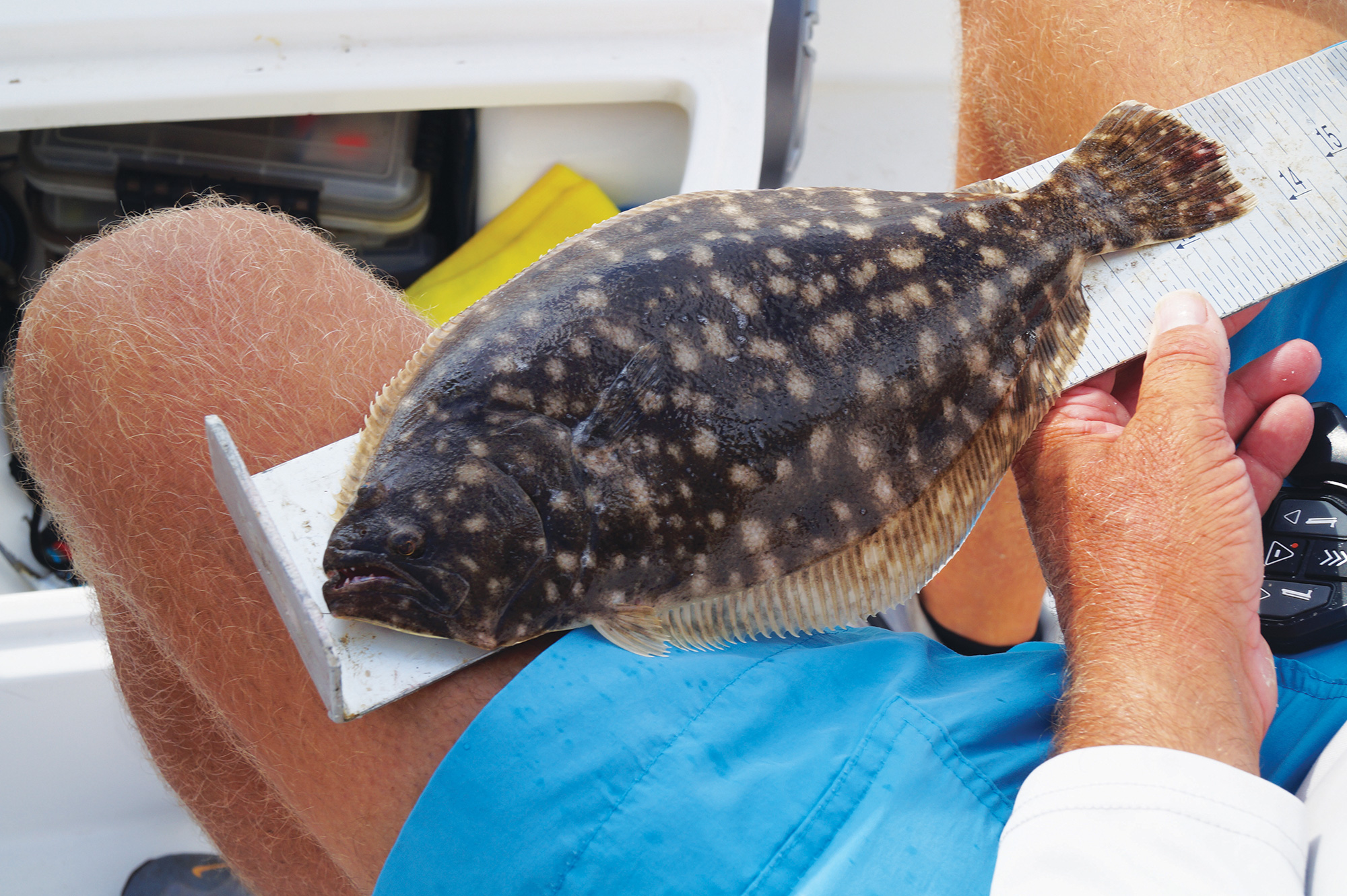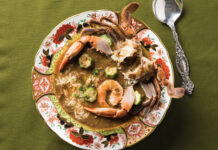
Four spinning rods are loaded into the rod holders of the 26-foot Contender bay boat, and shrimp pop and jump as they are poured into the roiling live well. The ice chest is loaded with waters and a few energy drinks, the latter of which guide Richard Rutland announces are his. “Don’t touch,” he teases. A few people apply sunscreen while someone else clicks their keys one last time, making sure their car is locked where it was parked next to the launch at Delta Port Marina in Coden. Here on the western branch of Fowl River, Delta Port is positioned perfectly to send boats into the Mississippi Sound, where speckled trout, redfish and flounder lay in wait, hiding behind small islands of grass and sand.
After a quick run at top speed heading southwest toward Cat Island, Rutland pulls back the throttle, turns off the ignition and sinks the power pole into the sand to hold the boat in position. He starts helping guests hook their shrimp through the right spot so they don’t fling off with the first cast. Three rods send line spooling out in different directions, and popping corks make their signature “whopp” as they are pulled forward and under the water with a jerk, only to pop back up again, showing where the bait lay in wait. Despite a few isolated thunderstorms on the radar, everything is in place to make this the perfect summer day fishing in South Alabama. The only thing unusual about this group — and the two other boats full of anglers that left the marina behind them at 7 am that morning? The fishermen are all women.

A Different Kind of Girls’ Trip
“I like taking women fishing,” Rutland says matter-of-factly. “You know why? They listen better than men.” The women holding rods all smile knowingly, like they are in on the joke. “You show a woman how to do something once and it’s over with. But guys think they’ve got it all figured out, especially old guys.”
The three anglers on Rutland’s boat are all experienced with a rod and reel and don’t need a lot of direction, although they would welcome it. One says her daddy was a commercial shrimper out of Bayou la Batre and she would go out with him for weeks on end as a child. Another says her father used to be a charter captain, leaving Dauphin Island with guests to go offshore for grouper. “I was his deckhand for three years when I was young.”
The women have come today for a fish tagging workshop put on by The University of South Alabama Stokes School of Marine and Environmental Sciences, the Dauphin Island Sea Lab’s Fisheries Ecology Lab and the Coastal Conservation Association, known as CCA, among others. The workshop was privately funded, but organized and led by scientists and PhD students who want to educate female anglers and increase the number of women reeling in inshore fish and reporting them.
The three boats that left Delta Port just after sunrise were carrying experienced female anglers, but other ladies came to the marina that day to learn the basics. Legendary Louisiana fishing guide Mary Poe, who has since retired to Dauphin Island, stands in the grass with a spinning rod in hand, showing a group gathered around her the proper way to cast. She is wearing a white tennis skirt, her red hair held off her face by a visor — perhaps not your prototypical fishing guide, but par for the course at today’s gathering.
Crystal Hightower, who is leading the workshop, sets up three targets for the casting practice: two stakes in the ground to allow anglers to practice casting between pilings for flounder, a large orange shrimp basket representing where a big bull red just boiled and a circle of rope to act like a trout slick. All the anglers take their turns casting with various methods at each of the targets. Only once does a popping cork hit a nearby parked car. “Someone should move that car!” elicits laughter. They talk about casting into the wind, letting your bait float past a slick and how to not get hung on a piling. These less-experienced anglers listen intently and visit with each other, making friends and gaining confidence.
“One of the main goals of this workshop is to get lady anglers together,” explains Hightower. She hosts a closed Facebook group so the women can continue to stay in contact, find a fishing buddy and ask questions without fear of ridicule. “We really want to support and promote our female recreational anglers in Alabama.”
Hightower has the stats to back up the need. She says recreational fishing license sales nationwide are 37% female. In Alabama, saltwater licenses are at just 18%, well below the national average. The tagging program, she goes on, is at about 4% female taggers. “We want to promote the ladies fishing community in general, and let them know about the tagging program. We want to get y’all tagging kits.”

Sara Gibbs, a PhD student working alongside Hightower at the workshop, says that the barriers to fishing many women experience can be alleviated with just a little education. “We want women to see that they don’t need that many complicated pieces of equipment, they don’t need that much time to go out fishing. It’s easier than they think.”
The tagging program is one way to entice women out into the boat, and the three guides taking them fishing today are the top taggers in the program: Rutland, Patric Garmeson and Theo Atkinson. “These are the guys who helped us start the program. They are the guys who put out the most tags every year,” says Hightower.
She explains that the tagging program gives researchers vital information about fish movement, growth and mortality. “We can use our recapture rates to estimate the fish mortality rate for Mobile Bay, and for the systems within it, like Fowl River, Dog River, Weeks Bay and so on.”
The tags, which look like small pieces of coated wire, are numbered with a unique identifier. If you tag or recapture an already tagged fish, anglers simply go online and enter the data: length of the fish, tag number and a precise location where it was caught. The program then lets the tagger and recapture angler know where their fish went, how many days at liberty, how much it grew. High-tower gives the three guides credit for the success of the program. “We’ve put out around 13,000 tags in the last seven years, thanks to these guys,” she says. “It’s pretty impressive, and we’ve been able to learn a lot.” The value to the angler is that you learn about fish, where they move, how they grow. At the same time, researchers gain valuable scientific and management numbers.
“We host tagging workshops for men, but we don’t take them fishing, so it’s not as much fun,” says Hightower with a playful smile. “But we do this same workshop over and over again so we have tag retention. Without the knowledge from the workshops, an angler will stick the tag in the muscle of the fish and it’s not going to stay. It will grow out. You need to stick it through a bone.”
With a live fish on the boat, you want to tag it as quickly as possible and return it to the water. Rutland says he writes down the tag number in a book before he even begins the process to expedite things. Some of the lady anglers get a chance to tag a live fish out in the Mississippi Sound, but others come back to the dock and continue to practice on an ice-cold speckled trout caught the day before. Here, the ladies can take their time while they each take a turn testing the tagging process and finding the right spot, asking questions and showing pride when they get it right. “I want you to get a good feel for it,” Rutland tells an angler in purple crocs and a pink trucker hat.
“You want to stick him behind the bony fin ray supports so the barb catches on one, like this.” He scratches a scale away and goes in with the barb towards the fish. “It looks like I went deep there, but I didn’t. It wasn’t a big deal to the fish,” and then he tugs on the tag to make sure it caught on the bone. “Go past the fish’s centerline to where you can grab that bone.”
The little orange piece of wire is left sticking out of the fish’s back, but Hightower assures everyone it poses no trauma to the fish. “And if you recapture a fish and want to keep it and cook it, there is no stigma associated with that. Just send us the information.”
One angler says she has caught fish with tags before, but never reported them. “I wasn’t registered in the program, but I’d like to know how to do it. I love the concept of seeing the travel of the fish, how they age, what are the patterns. I think it’s just cool.”
“We want it here for the next generations,” another woman interjects. Conservation is at the heart of all of this work, and the lady anglers are on board.
Rutland expresses concern about the future of the Bay, and as a full-time fishing guide, it is incredibly personal to him. He’s into his 17th season guiding clients who he says are mostly locals who want him to put them on the fish. Being on the water at least five days a week, he knows where the fish are and where they are heading. He also works with USA to get their researchers and students out on the water for various projects. “Crystal and I have been acoustic tagging bull reds. All next week we are targeting bonnethead sharks for another research project.”

But the federal mud dumping, as he calls it, from the deepening and widening of the Mobile ship channel, is top of mind. “It adds a lot of turbidity. They are pumping up that mud, displacing it and dispersing it, and it clouds up the water. I think that’s the reason why the grass is not growing in Mobile Bay anymore.” And without the grass, he explains, you lose necessary habitat for marine life — right down to the gobies and shrimp and crabs that are established in the benthic layer. “A lot of good growth is happening on the bottom, even where there aren’t grass beds, and that blanket of mud they want to disperse will choke everything out.”
He and others are heading to Washington, DC to meet with legislators about bay conditions that he says are often chocolate milk. “It’s 25 miles of water that are going to be affected by this.” He and other conservation experts want to end the thin layer disbursement by 2026, following the lead of other similar bodies of water across the country who found a different, better way to handle dredge spoil.
In the meantime, the more anglers on the water monitoring fish populations, the better information scientists and legislators will have to use when making decisions. That’s where these lady anglers-turned fish taggers come into play.
One of the guides returns to the dock with a group of soaking wet anglers in raincoats and smiles. The group had been dodging that cell of storms out on the Sound for the last hour and finally decided to call it a day. They tell the others practicing their casting with Poe that they caught a legal tripletail in a foot of water right off a nearby piling. “That was the last thing we expected!” an angler shouts. They tagged and released him, adding another fish to the list that might bring helpful information to local researchers. A pair of hands sporting bright blue nail polish stick forward to show how big the blackfish was. A lady wearing monogrammed deck boots tells everyone about the flounder she caught — almost legal, but not quite. “I wanted a dinner plate!” her fellow fisherman announces.
Or is it fisherwoman? Either way you phrase it, the workshop brought people together with a shared interest and made connections between anglers and scientists, empowering locals to pursue one of our area’s greatest pastimes with confidence and first-hand knowledge. Now we wait and see where the fish go.





